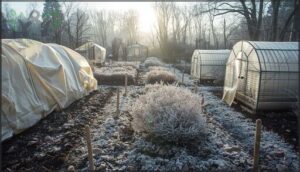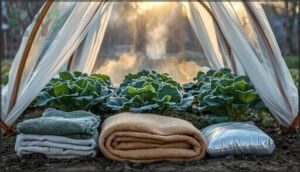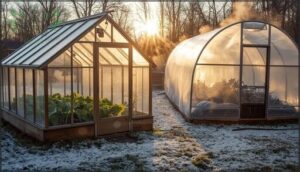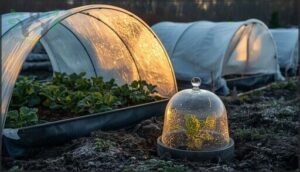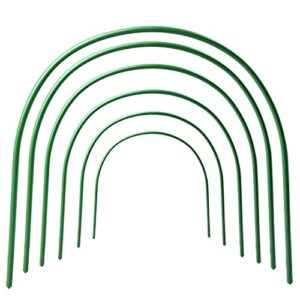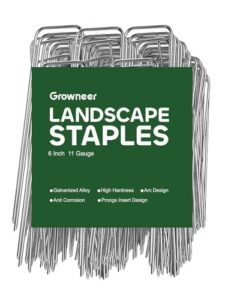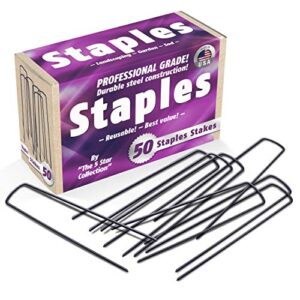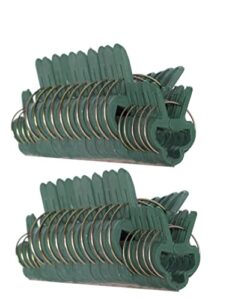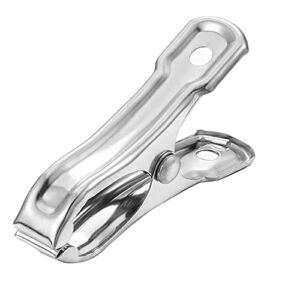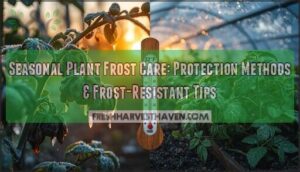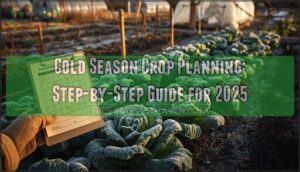This site is supported by our readers. We may earn a commission, at no cost to you, if you purchase through links.
A hard frost can wipe out months of gardening work in a single night. Tender perennials, vegetable plants loaded with late-season produce, even some supposedly hardy shrubs—all vulnerable when temperatures plummet. The difference between a thriving winter garden and a graveyard of blackened stems often comes down to the protective measures you take before that first freeze arrives.
Understanding which plants need safeguarding, when to act, and what methods work best isn’t guesswork. You’ll learn practical techniques that shield your garden from frost damage, from simple mulching strategies to choosing the right covers and products that extend your growing season well into the cold months.
Table Of Contents
- Key Takeaways
- Essential Winter Garden Preparation Steps
- Best Methods for Winter Plant Protection
- Choosing and Using Winter Plant Covers
- Top Products for Winter Garden Protection
- Frequently Asked Questions (FAQs)
- How do I protect my garden during the winter?
- How do I protect my plants from cold and Frost?
- Do you need a frost protector for winter gardening?
- Why do plants need a winter cover?
- What is the best winter plant cover?
- Why do plants need a winter protection layer?
- What is the best winter protection for plants?
- At what temperature should you cover your plants at night in winter?
- When should winter watering schedule be adjusted?
- How do indoor plants transition outside post-winter?
- Conclusion
Key Takeaways
- Apply 5-10 cm of mulch after the first hard frost to insulate roots and prevent freeze-thaw cycles that heave plants from the ground, keeping soil several degrees warmer through winter.
- Use medium-weight frost cloth (AG-30) for the best balance—it protects plants down to 6°F below ambient temperature while allowing 70% light transmission and remains reusable across multiple seasons.
- Water your plants deeply to 5-6 inches before freezes hit, since moist soil retains heat far better than dry ground and can raise root zone temperatures by up to 5°F.
- Time your protective actions before the first freeze arrives and remove covers gradually over two weeks after the last frost date passes, checking that nighttime lows stay above freezing for a full week to prevent damage.
Essential Winter Garden Preparation Steps
Before the first freeze hits, you need to take a few important steps to give your garden the best chance at making it through winter. Think of this as setting your plants up for success—checking their health, understanding your soil, and knowing which ones need extra attention.
Here’s what you should focus on to prepare your winter garden properly.
Evaluating Plant Health Before Winter
Before the first hard freeze hits, walk through your garden and check each plant carefully. You’re looking for signs of trouble that could worsen over winter. Strong disease prevention and pest control now mean healthier plants come spring.
- Look for discolored leaves, wilting stems, or lesions that signal disease
- Check for pest infestations like white fungal tufts under leaves
- Note which plants show vigor and which seem weak or damaged
Keep simple records of plant health and microclimate impacts around your yard. This helps protect root systems and guides your winter prep decisions. Preparing soil well impacts soil aggregation.
Assessing Soil Conditions and Moisture
Now check your soil health—because what’s happening below ground matters just as much. Test your winter soil pH; aim for around 6.5 to support nutrient flow. Healthy garden soils need 3-5% organic matter for better soil moisture levels and structure. To understand the acidity or alkalinity, use a soil pH colour chart. Use a simple slake test to assess soil aggregation and drainage trends. In well-conditioned soil, water infiltrates quickly, keeping roots protected all season.
| Soil Property | Winter Target Range |
|---|---|
| pH Level | 6.1-7.0 (moderately acidic) |
| Organic Matter | 3-5% minimum |
| Moisture Content | 25-30% with mulch |
Identifying Frost-Susceptible Plants
After understanding your soil, you need to know which plants can’t take the cold. Frost damage hits hardest when tender tissues freeze—buds, young leaves, and fresh growth go first. Regional climate impact matters too; some plants lose cold hardiness quickly after a warm spell. Here’s what to watch:
- Warm-season crops like tomatoes, peppers, and beans die near 32°F
- Thin-leaved plants with high water content freeze faster
- Recently pruned or actively growing plants show more vulnerability
- Tropical species and tender perennials need protection below 36°F
Selecting Cold-Hardy Crops and Varieties
Once you’ve flagged vulnerable plants, build your winter lineup around proven survivors. USDA Zones guide your crop hardiness choices—kale like ‘Vates’ tolerates near 0°F, while ‘Winterbor’ withstands 5°F.
Brussels sprouts, spinach, and carrots deliver winter nutrition and frost tolerance. Choosing cold-hardy crops and frost-tolerant plant varieties means reliable harvests when tender options fail.
Best Methods for Winter Plant Protection
Protecting your winter garden doesn’t require complicated systems or expensive equipment. A few smart, straightforward methods can make the difference between plants that barely survive and those that thrive through the coldest months.
Let’s look at five reliable techniques you can start using right away.
Mulching for Soil Insulation
Think of mulch as a warm blanket for your garden soil. Apply a 5–10 cm layer of organic materials like straw, wood chips, or shredded leaves after the first hard frost. This timing matters because you’ll protect the roots while reducing freeze-thaw cycles that heave plants from the ground.
Apply 5–10 cm of mulch after the first hard frost to insulate roots and prevent damaging freeze-thaw cycles
Proper mulching delivers four key benefits:
- Lowers soil freezing depth by up to 26 cm
- Keeps soil several degrees warmer through winter
- Cuts moisture loss when water availability drops
- Stops destructive expansion and contraction in your beds
Keep mulch a few inches from plant stems to prevent rot while insulating the soil underneath.
Pruning and Preparing Perennials
After the first hard frost, give perennials a pruning to cut down on pests and diseases by 80%. Use sterilized tools with 70% alcohol between cuts, and remove diseased foliage to the crown. Species specifics matter—evergreens like lavender wait until spring, while hostas get trimmed in fall. Leave some seed heads standing for wildlife impact and winter bird food.
| Perennial Type | Pruning Timing |
|---|---|
| Hostas, peonies, daylilies | After first hard frost |
| Lavender, hellebores, evergreen ferns | Wait until spring |
| Tender perennials (cannas, dahlias) | Cut to ground, lift and store |
| Tall herbaceous (collapsed by frost) | Remove to crown level |
Watering Strategies Before Freezes
Before temperatures plummet, water your plants deeply in the morning. Moist soil retains heat far better than dry ground, raising root zone temperatures by up to 5°F.
Aim for 5–6 inches of watering depth, adjusting for your soil type. Clay soils hold moisture longer, while sandy soils drain faster.
This simple step boosts survival rates and shields roots from freeze damage through better soil moisture and thermal protection.
Using Containers for Movability
Containers give you a powerful advantage: you can move vulnerable plants out of danger when frost threatens. This movability has driven an 18% adoption surge since 2020, especially in urban gardens where space is tight.
For best results with overwintering strategies:
- Choose frost-resistant materials like resin or fiberglass—they deliver 85% survival rates versus 60% in clay pots
- Use containers over 10 gallons for 30% better root protection through container microclimates
- Group and wrap pots with burlap, cutting frost damage by 40%
Economic benefits add up fast. Protecting container plants saves 70% over replacing them yearly, while container gardening trends show it now accounts for 25% of winter harvests. Insulating garden plants in movable containers simply works.
Installing Windbreaks to Shield Plants
Windbreaks act like shields, cutting winter wind speed by up to 70% and raising temperatures by nearly 1°C in protected zones. Place double rows of high-density trees perpendicular to prevailing winds for maximum effect. Utilizing windbreaks for plant protection reduces cold stress by 19% and attracts 2–3 times more beneficial wildlife during harsh months.
| Windbreak Species | Placement Strategies | Economic Returns |
|---|---|---|
| Cylinder-shaped evergreens | 10–15× tree height protection | $12.19 per linear foot |
| High LAD trees | Perpendicular to wind | 44% yield increase |
| 40–60% porosity design | Double-row configuration | 3–5 year payback |
| Medium height varieties | Snow retention focus | 16% soybean gain |
Choosing and Using Winter Plant Covers
The right cover can mean the difference between a thriving winter garden and a field of frost-damaged plants. You’ve got several solid options, from lightweight frost cloth to sturdy cold frames, and each one works best in specific situations.
Let’s look at how to choose the protection that fits your garden’s needs and use it effectively through the cold months.
Selecting The Right Cover Materials (Frost Cloth, Blankets, Row Covers)
Choosing the right cover depends on how cold it gets and how much light your plants need. Lightweight frost cloth (AG-19) protects down to 28°F and lets 85% light through, while heavier options like AG-50 guard against 24°F but only allow 50% transmission.
Secure garden covers tightly against wind, and consider layering materials when temperatures drop below 20°F for extra protection.
Building and Using Cold Frames and Hoop Houses
Cold frames and hoop houses offer passive solar heating that extends your harvest by months. Build cold frames with a 10 to 15 degree back-to-front slope facing south, and vent them when temperatures hit 85°F—even in winter. These DIY cold frames maintain air five to ten degrees warmer than outside.
Space hoop houses four feet apart in snowy climates for structural integrity.
Applying Floating Row Covers and Cloches
Floating row covers and cloches create a warm bubble around your plants when frost threatens. Lay lightweight covers directly over sturdy crops, or build hoops twelve to thirty-six inches high to prevent plant abrasion on delicate foliage like tomatoes.
Here’s what your cover installation delivers:
- Medium-weight covers provide four to six degrees of frost protection while transmitting seventy to eighty-five percent sunlight
- Heavyweight fabrics shield overwintering crops down to eight degrees colder than ambient air
- Bell cloches trap two to three degrees Celsius of extra warmth around individual transplants
- Proper material reuse across seasons makes winter protection affordable
Vent cloches daily to prevent heat buildup.
Timing The Removal of Winter Protections
Once you’ve shielded your plants through winter, watch for three signals that say it’s time to lift protections: your area’s last frost date passes, soil warms past forty degrees at root depth, and nighttime lows hold steady above freezing for a week. Pull covers too soon, and late freezes undo months of care.
Start a two-week acclimation by removing covers during sunny afternoons, then replacing them at dusk. This gradual exposure prevents leaf scorch and water stress that sudden full removal causes. Check short-range weather forecasts daily—cloud cover and wind speed shift frost risk by several days beyond average dates.
Here’s your staged removal plan:
| Week | Action |
|---|---|
| Week 1 | Remove covers during warm afternoons; replace at night if temps drop below 35°F |
| Week 2 | Use lighter fleece layers; monitor soil thaw and microclimate conditions |
| Week 3 | Full removal after last frost date plus seven to fourteen days for safety buffer |
Urban gardens near brick walls or enclosed courtyards often warm several degrees faster than open sites, letting you remove protections a week earlier in those sheltered microclimates. South-facing slopes thaw first. Rural gardens need extra caution—late spring freezes still arrive two to three weeks after average dates in outlier years, especially in northern plains and higher elevations where May frosts remain common.
Ensuring Proper Airflow and Sunlight Exposure
Keeping covers airtight sounds safe, but sealed barriers trap moisture and block airflow—two conditions that rot roots faster than cold ever could. Your plants need air circulation under frost blankets, even when temps drop. Raise covers a few inches above foliage to create insulating air pockets that regulate temperature while sunlight exposure fuels photosynthesis through translucent materials.
Effective airflow techniques include:
- Loosening cover edges during sunny afternoons to release trapped humidity and prevent fungal growth
- Spacing plants several inches apart before covering, allowing natural ventilation between stems and leaves
- Using vented row covers or adding small openings in solid materials for continuous moisture management
Monitor microclimate conditions weekly—lift a corner and check for condensation beads or musty odors. If moisture collects under covers, your ventilation needs adjustment. Install a small battery-powered fan in cold frames or prop covers open during midday warmth. Winter sunlight may seem weak, but plants exposed to late-winter light show up to fifty percent more growth the following season compared to those kept in darkness.
Balance protection with monitoring practices that prevent the stuffy, damp conditions where diseases thrive.
Top Products for Winter Garden Protection
You’ve got your covers and your cold frames ready, but the right accessories make all the difference when it comes to securing and supporting your winter protection setup. From sturdy hoops that hold frost blankets in place to clips that keep everything from flapping loose in the wind, these tools help your protection methods actually work.
Let’s look at five products that’ll make winterizing your garden easier and more effective.
1. ASSR Greenhouse Support Hoops 6 Pack
You’ll get solid winter gardening results with the ASSR Greenhouse Support Hoops 6 Pack, designed for reliable plant protection through frost and cold snaps.
These garden hoops measure 18.9 inches high and 47.2 inches long, with plastic-coated steel construction that ensures hoop durability season after season.
Installation ease is a standout feature—just push them into soil by hand, no tools needed. Cover compatibility works well with frost cloth, plastic film, and insect netting, giving you garden versatility for different crops.
At $13-$17 per pack, the cost-effectiveness makes winter protection accessible for any gardener.
Best For: Home gardeners looking for an affordable way to protect winter vegetables and extend their growing season without building a permanent greenhouse structure.
- Quick 15-minute setup with no tools required—just push the rust-resistant hoops into soil and drape your cover material over them.
- Raises under-cover temperatures by up to 7°F during cold nights, helping you harvest 4-8 weeks longer in fall and winter.
- Works with multiple cover types (frost cloth, plastic film, insect netting) so you can swap protection based on what your plants need.
- The 18.9-inch height is shorter than some gardeners expect, which limits use for taller crops like mature kale or Brussels sprouts.
- May not span wider raised beds (over 4 feet) without bending or adding extra support.
- Product descriptions can be misleading about actual coverage area, so double-check measurements against your garden beds before buying.
2. Heavy Duty Galvanized Landscape Staples
You can lock down frost cloth, mulch, and row covers with heavy-duty galvanized landscape staples—100 garden staples in 6-inch lengths that handle root protection and soil insulation needs.
The 11-gauge steel construction offers staple corrosion resistance that outlasts plastic landscape pins by 60%, with soil pull-out strength up to 140 pounds.
Installation best practices recommend spacing them 12 to 36 inches apart along covers, pushing 4 to 6 inches deep for secure anchoring.
These alternative fasteners work across freeze-thaw cycles, maintaining 90% strength retention through multiple winters.
Best For: Gardeners who need reliable, reusable anchors to secure winter covers, mulch, and landscape fabric through freeze-thaw cycles without frequent replacement.
- Heavy-duty 11-gauge galvanized steel resists corrosion 3x longer than untreated steel and outlasts plastic anchors by 60%, with over 90% strength retention across multiple winters.
- High pull-out resistance up to 140 pounds keeps frost cloth, row covers, and tarps firmly in place even in windy conditions and freeze-thaw cycles.
- Reusable for multiple seasons with an 80% reuse rate, making them cost-effective compared to single-use plastic alternatives.
- May struggle in very dry, sandy, or highly compacted rocky soils where pull-out resistance drops and bending can occur during installation.
- Limited to 6-inch length, which might not provide enough anchoring depth for extremely heavy materials or high-wind areas.
- Galvanized coating eventually shows rust after 18-24 months of continuous outdoor exposure, though functional performance remains adequate through multiple seasons.
3. Garden Staples Landscape Stakes Ground Pins
You need reliable landscape pins that won’t bend or rust halfway through winter. The 5 Star Collection’s 50-pack garden staples offer alloy steel construction at 6 inches long, securing frost blankets and ground covers with staple durability that resists corrosion.
Installation techniques involve pushing pins 4 to 6 inches deep, spaced every 4 feet for plant protection. Material options like galvanized steel provide greater environmental impact compared to non-coated alternatives.
Cost analysis shows these garden staples deliver budget-friendly anchoring for protecting plants across your winter garden setup.
Best For: Homeowners and gardeners looking for an affordable way to secure landscape fabric, frost covers, or drip irrigation systems in typical garden conditions.
- 50-pack gives you plenty of stakes for multiple projects—enough to cover around 200 square feet of fabric with proper spacing
- 6-inch length works well in most soil types and holds down fabric, netting, or hoses without complicated installation
- Budget-friendly option that gets the job done for seasonal garden tasks and temporary anchoring needs
- Not galvanized, so these stakes can rust quickly in wet or humid conditions—not ideal for year-round outdoor use
- Some users report the stakes bend or break during installation, especially in hard or rocky soil
- Durability concerns compared to heavier-gauge galvanized options that last through multiple seasons
4. Gentle Green Garden Plant Support Clips
You want clips that won’t crack when temperatures drop and frost hardens everything in your garden. The RamPro 40-piece set combines metal spring rings with weatherproof plastic bases, giving you clip durability through multiple freeze-thaw cycles.
Material properties like UV-resistant polypropylene prevent brittleness during winter plant care.
Use them for securing covers to hoops, fastening frost cloth edges, or creating integrated systems where stems and protective fabrics attach to the same stakes. They’re gentle on cold-stressed plant tissue while maintaining a firm grip for cold weather protection.
Best For: Gardeners who need reliable clips to secure frost covers and support cold-sensitive plants through winter without damaging brittle stems.
- Metal spring rings combined with weatherproof plastic resist cracking through repeated freeze-thaw cycles
- UV-resistant material maintains grip strength across multiple seasons of outdoor exposure
- Gentle rounded design distributes pressure to avoid crushing stems when plant tissue is most vulnerable to cold stress
- Some users report the plastic hinges can break under stress, especially with thicker stems
- May not hold up well for very heavy plants or in high-wind winter conditions
- Quality can be inconsistent, and while broken clips can sometimes be repaired by snapping the hinge back together, this isn’t always successful
5. Greenhouse Clips Garden Netting Clamps
Stainless steel greenhouse clips lock fabrics onto hoops with attachment strength that matters when cold winds test your winter garden plant protection tips. These 2-inch clamps open to 0.8 inches, securing up to three layers of frost cloth on pipes while maintaining grip through freeze-thaw cycles.
Clamp durability comes from material innovations in UV-resistant construction, though you’ll find sustainable options emerging as market growth pushes biodegradable designs.
Check pipe diameter before buying—some models slip on narrower tubing, compromising your cold weather gardening techniques when protecting plants from cold weather demands reliable garden maintenance tips.
Best For: Gardeners who need reliable clips to secure frost cloth, shade netting, or row covers on greenhouse hoops and garden frames through harsh weather conditions.
- Stainless steel construction holds strong through freeze-thaw cycles and can grip up to three layers of protective fabric at once
- Opens wide enough (0.8 inches) to fit most standard greenhouse pipes and PVC hoops while maintaining secure attachment
- Value pack of 20 clips gives you plenty for multiple garden projects without breaking the bank
- Spring mechanism isn’t stainless steel, so it may wear out faster than the rest of the clip in wet conditions
- Won’t fit all pipe sizes—especially struggles with narrower tubing like 5/8-inch hoops where clips can pop off easily
- Manual measurement variations mean clip sizes aren’t perfectly consistent across the pack
Frequently Asked Questions (FAQs)
How do I protect my garden during the winter?
Think of winter gardening as tucking your plants in for a long sleep.
You’ll protect roots with mulch, use garden covers for frost protection, and follow a winterizing checklist for cold weather plant care success.
How do I protect my plants from cold and Frost?
Protect plants from cold and frost by using row covers, which provide 80-90% effectiveness, applying mulch for soil insulation, watering before freezes, and monitoring plant hardiness zones for emergency frost measures.
Do you need a frost protector for winter gardening?
Your frost protection needs depend on plant hardiness zones and microclimate considerations.
Assess frost risk in your area—most gardens benefit from protectors when temperatures drop to 30°F or below, ensuring cold weather gardening success.
Why do plants need a winter cover?
Winter covers shield your plants from freeze damage and prevent desiccation from harsh winds. They regulate temperature, suppress disease, control soil erosion, and promote healthy spring regrowth—essential for effective cold weather plant survival.
What is the best winter plant cover?
Cover breathability wins over sealed plastic every time. Medium-weight frost cloth (AG-30) hits the sweet spot: 6°F protection, 70% light transmission, and cost-effectiveness.
It’s reusable, adaptable, and balances plant hardiness needs perfectly.
Why do plants need a winter protection layer?
Your plants need insulation from cold temperatures and freeze damage. Protection layers stabilize temperature fluctuations, support moisture retention, maintain soil health, prevent physical damage, and encourage early growth when spring arrives.
What is the best winter protection for plants?
Selecting suitable cold weather protection starts with plant hardiness and climate specifics.
Combine covers, mulch, and windbreaks for long-term protection.
Cost analysis helps balance sustainable options with effective winter plant care results.
At what temperature should you cover your plants at night in winter?
You should cover plants when nighttime temperatures drop to 32°F or below. Tender plants need protection earlier—around 36°F. Forecast interpretation and microclimate effects help prevent frost damage effectively.
When should winter watering schedule be adjusted?
Adjust your winter watering schedule at least four times yearly, monitoring rainfall, temperature fluctuations, and soil moisture. During dormancy stages, plant needs decrease dramatically.
Before freezes, water thoroughly to prevent dehydration, ensuring soil stays moist but not waterlogged.
How do indoor plants transition outside post-winter?
Gradually introduce your indoor plants to outdoor conditions over 10 to 14 days. This hardening process prevents leaf damage and stress.
Start with morning light acclimation, then slowly increase exposure while monitoring temperature thresholds and adjusting watering.
Conclusion
Winter garden plant protection isn’t complicated—it’s consistent. Evaluate your plants, apply mulch correctly, choose the right covers, and time your interventions well.
Each method builds on the others, creating layers of defense that work together when temperatures drop.
You’ve now got the knowledge to shield tender growth from frost, extend harvests through cold snaps, and bring your garden through winter intact. The difference between survival and loss? Taking action before that first freeze hits.
- https://extension.missouri.edu/news/its-time-to-protect-plants-from-frost
- https://www.rhs.org.uk/science/articles/winter-plant-survey
- https://gardenersmortlake.org.uk/blog/defend-your-garden-winter-plant-protection-tactics
- https://bonnieplants.com/blogs/garden-fundamentals/row-cover-fabric-works-like-a-blanket-for-your-plants
- https://learn.eartheasy.com/guides/how-to-use-cold-frames-in-your-garden/


